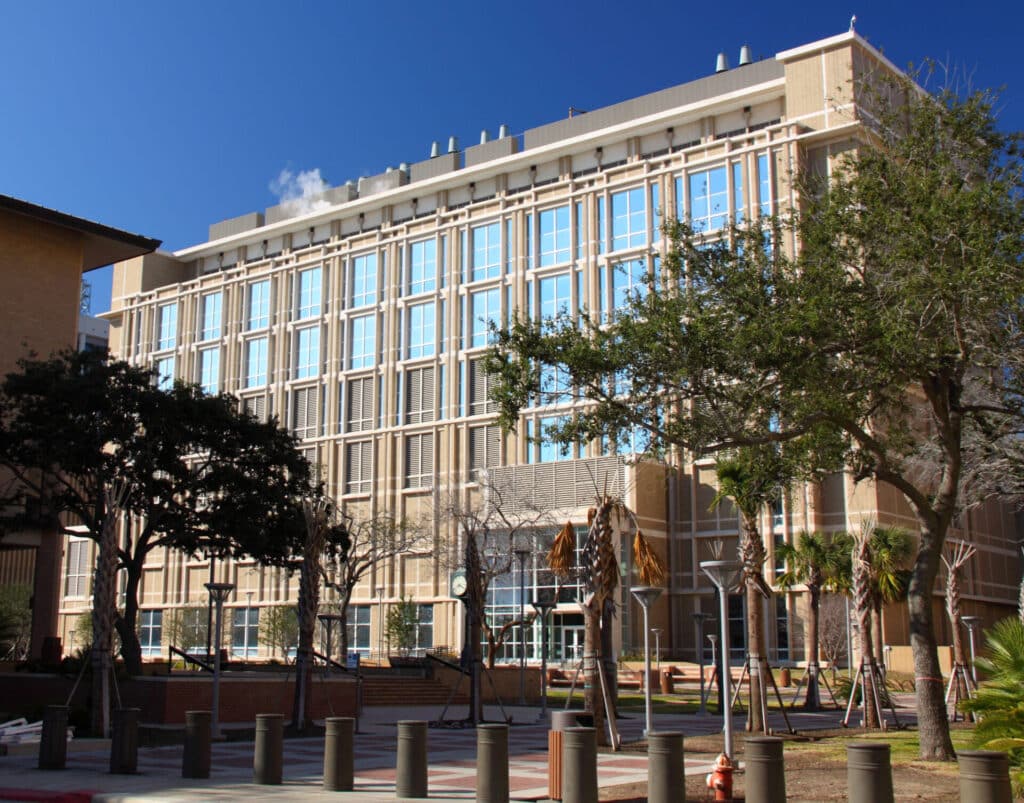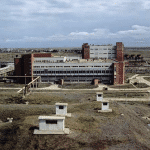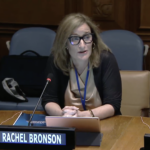Despite risk-management gaps, countries press ahead with new labs that study deadly pathogens
By Matt Field | January 5, 2023

How the times have changed.
A little over 17 years ago, in an auditorium at the University of Texas Medical Branch in Galveston Texas, a motley crew of dignitaries gathered to celebrate the construction of a state-of-the-art biological laboratory. Biosafety-level (BSL)-4 labs like the Galveston National Laboratory are the sort of places where disease researchers don head-to-toe protective gear and breathe pumped-in air, lest they get exposed to any highly lethal and contagious pathogens. On hand that day were Anthony Fauci, then the head of the National Institute of Allergy and Infectious Diseases, and two top Republican officials, former Sen. Kay Bailey Hutchison and former House Majority Leader Tom DeLay.
“We are going to be a one-stop shopping center for all of the bad things that might happen,” Hutchison said, according to the Galveston County Daily News, “but more importantly, we are going to find the cures.” DeLay, the paper said, told the crowd that the lab would be among the most secure and advanced in the world. “It’s a place where ingenuity will be used as a shield and not a weapon,” he said. “There are many, many threats, and we would not be able to respond to them without the kind of research that will take place in this laboratory,” Fauci added.
Two decades later, it’s difficult to imagine the same kind of gathering—Fauci, who retired last month, rubbing shoulders with leading Republican figures in Congress. Now, many Republicans say Fauci played a role in improperly funding research on coronaviruses in a lab in China, and the party has made probing the origins of COVID-19 and US-government funded pathogen research in China a centerpiece of its agenda.
The pandemic and political polarization have placed research on the riskiest pathogens, the sort studied in BSL-4 labs, squarely in the center of a political hurricane in the United States. And that’s not the only challenge BSL-4 and other so-called “high-containment” labs face. On the geopolitical front, the Russian government has dramatically escalated a disinformation campaign alleging that US-linked biological labs in Ukraine and other countries formed from former Soviet republics are fronts for bioweapons research—allegations that authorities at the United Nations and independent experts roundly dismiss.
In this era of disinformation targeting pathogen research labs and politicized mistrust of the facilities, a team of researchers now hopes to provide authoritative information about the most secure of these labs, via a map that gives the locations of BSL-3+ and BSL-4 labs and by assessing the governmental research policies that govern them.
George Mason University biosecurity expert Gregory Koblentz, who co-leads the project with Filippa Lentzos, a King’s College London researcher, said shining a light on the proliferation of the labs can help cut through misinformation about them and allow for a clear-eyed look at how these beneficial, yet also potentially risky facilities are managed. “One of the goals of our project is to increase transparency and educate the public and policy-makers about these labs’ activities and what governance measures are necessary to ensure they are operating safely, securely, and responsibly,” Koblentz said. “Accurate information is a prerequisite for an informed debate on the benefits and risks posed by these labs.” (The Bulletin partnered with the team to produce an interactive map featuring information on the labs.)
Why are many countries building new high-containment labs? Are there adequate regulations in place to ensure labs are managed safely? I talked to Koblentz to learn the answers to these questions and more.
The COVID-19 pandemic has led to a building boom in labs. Since the pandemic began, nine countries have announced the construction of 12 new BSL-4 labs. (Biosafety levels range from one to four.) For five of these countries, the labs would be their first maximum-containment facilities. Governments saw in the pandemic a justification for the large investment BSL-4 labs require, Koblentz speculated. The labs are important to research on diseases like Ebola, and a country might want to have one of them to stay ahead of the next emerging disease threat. Plus, Koblentz said, they also are a status symbol.
“Countries also want the prestige of having a BSL-4 lab, which is more common than it used to be but still not that common,” Koblentz said. “And there’s also probably some bureaucratic politics and scientists who just want the new shiny toy, and so this is their time to get that.”
The team found a total of 69 BSL-4 labs in use or under development, 10 more than Koblentz and Lentzos found when they released the first version of their study in 2021.
It’s not just the most secure labs that are proliferating. While BSL-4 labs are reserved for experiments involving the gnarliest germs, another group of high-end research facility has been proliferating, as well. BSL-3+ or “enhanced” labs are billed as having a higher level of biosafety than BSL-3 facilities. Koblentz and Lentzos added these labs to the most recent update to their project, finding at least 55 such facilities. BSL-3+ labs, Koblentz said, work on pathogens such as the 1918 influenza strain that killed some 50 million people or highly pathogenic avian influenza. They are also places where researchers enhance attributes like the virulence of pathogens in so-called “gain-of-function” experiments. Compared to BSL-4 labs, official governmental guidance on BSL-3+ labs is sparse, and there are significantly more of the facilities today than there were 10 years ago, the team found.
“We want to highlight the growth in the number of these labs, as well as the lack of really comprehensive guidance from either national regulatory authorities or from international organizations about what these labs should be doing in order to make sure that they’re conducting their work safely, both for the sake of their own researchers or for the wider community,” Koblentz said.
Many countries with BSL-4 labs have gaps in their life sciences research governance. Since Koblentz and Lentzos released the first report in 2021, they’ve developed scorecards that assess the 27 countries that have or plan to have BSL-4 labs on what the pair call “biorisk management.” The rankings “measure the ability of a country to safely, securely and responsibly operate high-consequence biomedical research facilities.” The team has also used other pre-existing indices to score countries on “general governance and stability,” Lentzos said in a Dec. 9 presentation on the team’s work.
The biorisk rankings indicate, for example, whether countries have national laws on biosecurity or whether their policies require screening of synthetic DNA orders, among other criteria. Of the ranked countries, five have a low score on overall biorisk management, including some, like India, that are building new high-containment labs. Seven countries had a high score and 15 a medium one.
“BSL-4 labs take a very long time to build. This is not something you announce, and then it gets built the next year. It can take five or 10 years to build it,” Koblentz said. “So these countries have the time to develop the governance framework and the capacity to operate them successfully. But they need to start now.”
Many countries lack dual-use research policies. Of all the rankings Koblentz and Lentzos put together, perhaps the most striking assesses countries on their dual-use policies. These are meant to ensure research is done with an eye to how it could be misused—a scary proposition given the work going on in BSL-4 labs. Only Canada scored highly on the dual-use policy ranking. Many countries scored zero. “For a lot of countries, they just got zero because they have nothing—either at the government level or at the lab level or within other stakeholders,” Koblentz said. “And so definitely the biggest gap that we identified is this oversight of dual-use research.”
While the United States has a dual-use research policy, it applies to government-funded research. “The United States gets partial points for having oversight by funding agencies, but we don’t get full credit because this is a policy. This is not legislation, and it excludes privately funded research entirely.” In all, 24 countries scored poorly on this ranking, including Germany, Japan, and other developed countries.
The rankings don’t measure what actually happens, on the ground. The researchers stress that when looking at national policies on biosecurity or other aspects of lab governance, they are seeing only part of the picture. Local regulations could also play a role in some cases, Koblentz said. And it’s difficult to know how well governments are enforcing regulations. The scorecards don’t address implementation.
“Even with the best written regulations, it’s still a matter of what happens when you operate a laboratory,” Koblentz said, “And implementation, compliance, can be a problem in any country. In several countries there have been lab accidents at BSL-4 labs that have resulted in infections of researchers. So this remains a high-risk environment because they are doing work that is complicated.”
The governance and stability rankings, based on data from the World Bank and other organizations, serve as one way to assess how things might be operating in real life, Lentzos said at the Dec. 9 presentation. A look at these scores gives reason to worry.
Most planned BSL-4 labs “are to be built in countries that scored 50 percent or lower on both governance and stability,” she said. “To us this raises serious questions about the ability of these countries to effectively implement national biorisk management policies.”
While high-containment labs perform vital research on, say, vaccines, there have been accidents involving pathogens under study, including at the BSL-4 level. In 2015, for example, the CDC determined that live Ebola virus may have been transferred from the agency’s Ebola lab to a facility with a lower level of biosafety, requiring a technician to undergo 21 days of monitoring. A decade earlier, a Russian scientist working on an Ebola vaccine died after accidentally pricking herself with a contaminated needle at the Vektor Research Institute of Molecular Biology. A 2011 workshop run by the National Research Council, found that over 1,200 laboratory acquired infections occurred between 1978 and 1999. In 22 of those cases, the accidents proved fatal.
Given the importance and risk profile of high-containment labs, it’s critical to examine how well government policies address biosecurity and biosafety. But that effort could be complicated. In the United States, for instance, where the government is re-evaluating biosecurity policies, much of Congress’s recent interest in the matter seems to have related to partisan investigations of Fauci or investigations into the origins of COVID that some perceive as “xenophobic.” Strengthening biosecurity and biosafety policies, Koblentz said, “just gets a lot harder when the political environment is much more polarized and partisan.” With so many labs in operation in the United States and elsewhere, and many more in the pipeline, weak biosecurity governance might not be a luxury the world can afford.
(For more about this topic, see the Bulletin‘s previous, 2002 article by Eileen Choffnes titled Bioweapons: New Labs, More Terror)
Together, we make the world safer.
The Bulletin elevates expert voices above the noise. But as an independent nonprofit organization, our operations depend on the support of readers like you. Help us continue to deliver quality journalism that holds leaders accountable. Your support of our work at any level is important. In return, we promise our coverage will be understandable, influential, vigilant, solution-oriented, and fair-minded. Together we can make a difference.
Keywords: BSL-3, BSL-4, Russia-Ukraine
Topics: Biosecurity
















The problem is not only more level IV biolaboratories but where they are located. Most are in urban areas for the convenience of the scientific community. That implies an infected worker can go out the door and infect 50 people using mass transit going home. Such facilities should be located outside urban areas where everyone commutes by car and there is a much better chance of controlling an outbreak.
The question is a bit murkier: gain-of-function is an intentionally neutral word that can cover pacific research but also not-so-pacific one, a term used after the ban on biological warfare but with an undefined span. And we should be more clear about what’s hypothesis and what’s fact. As NYT’s Tufekci has uncovered, there’s a letter from Daszak to DOD asking permission for Wuhan’s lab to add the spike protein to bats’ virus: and this shows the range of gain-of-function research and at the same time confirms where Wuhan’s control was (adding to the fact that US financing stopped only after… Read more »